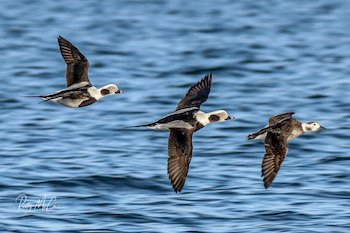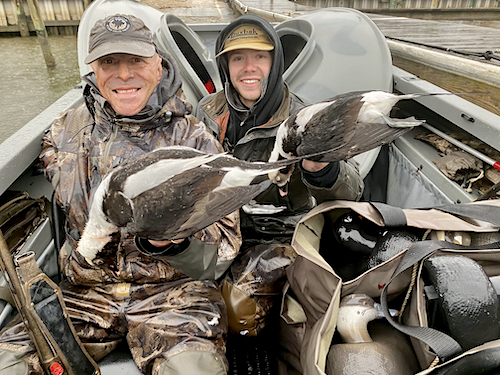Long-tailed Duck

Long-tailed Duck (Clangula hyemalis), formerly referred to as oldsquaw, is a small attractive sea duck occurring in northern coastal water throughout the entire Holarctic region. As its name implies, characterized by extremely long tail feathers that stream behind while in flight, are held erect on the water, and persist year-round. White plumage creates a high forehead appearance on drakes. Drake’s black bills are small and almond-shaped, a pink patch in the middle. Large gray area around the eye, black patch on the neck, chestnut patch below that. The drakes chest, mantle and back are black, blanketed with elongated, pointed white scapulars. Breeding plumage is almost the opposite of nonbreeding plumage, with the drakes displaying a pitch-black head and large white and gray patch around the eye. The back is a dark brown with slender light brown feathers streaking along it. Females are brown, with a white eye streak and collar, and a gray chest. Absolutely gorgeous bird.
Available Hunts
-
Alaska King Eider Hunting
Alaska King Eider hunt tops the life-list of most avid duck hunters and bird collectors.
...read moreAlaska King Eider hunting is for the true adventurer-collector that wants to hunt the most beautiful North American duck. King Eider, Harlequin Duck, Long-tailed Duck, White-wing Scoter.
- 100% success rate on trophy king eiders
- Most practical place on earth to hunt king eider trophies
- Dedicated staff, 40 years combined guide experience
- GetDucks.com pre-trip and travel services best prepares you for success
- Top-of-the line equipment
- As featured in Shooting Sportsman, Wildfowl, more December 2012
Rate: $7,000 -
New England Sea Duck Hunting
World renown for its eider hunting, New England waterfowling offers an incredible change of scenery and is an excellent place to check off lots of North America waterfowl species. RPM Outdoors specializes in making your hunt priorities a reality.
...read more- Decade-plus experience for trophy eiders, other sea ducks, divers, dabblers, mergansers, geese
- Best place in US to harvest prime American black ducks
- Customized hunt plans reflect hunter priorities, not a “one size fits all” type 1/2-day hunt
- Includes hotel accommodations, full-day hunting, continental breakfasts, made-to-order lunches
- Recognized as foremost among US waterfowl collectors and taxidermists
- Nearby non-hunting spouse activities abound
Rate: $1,950 for 3-day inclusive package -
Nova Scotia Sink Box Duck Hunting
Incredible sink box duck hunting in beautiful Nova Scotia Canada for scoters, long-tailed ducks and black ducks
...read moreStep into history and experience authentic Nova Scotia duck hunting. Banned in the US in 1918, sink box duck hunting in an exciting and effective means of putting unsuspecting ducks right on the deck.
- 20+ years sink box guiding experience
- November and December
- Unique experience, affordable rates
- Long-tailed Duck (oldsquaw) and American Black Ducks primarily
- Available only through GetDucks.com.
Rate: $2,500 -
Nova Scotia Sink Box Duck Hunting
Incredible sink box duck hunting in beautiful Nova Scotia Canada for scoters, long-tailed ducks and black ducks
...read moreStep into history and experience authentic Nova Scotia duck hunting. Banned in the US in 1918, sink box duck hunting in an exciting and effective means of putting unsuspecting ducks right on the deck.
- 20+ years sink box guiding experience
- November only
- Unique experience, affordable rates
- Long-tailed Duck (oldsquaw) and American Black Ducks primarily
- Choose 1x hunt daily, either sink box hunt or black ducks
- Available exclusively at GetDucks USHuntList
Rate: $2,800

During the North American breeding season, the long-tailed duck can be found in freshwater wetlands from the Aleutian Islands, along the northern coast of Canada, Newfoundland, and all the coastlines of Greenland. This is the only time of year where they do not spend most of their time on the water. After selecting a mate, females will nest near each other when the eggs are laid, while the males leave to molt. The young are solely raised by hens. Long-tailed ducks do not migrate far to their wintering grounds which include the Aleutian Islands (there are resident long-tailed ducks there, too), along the Pacific Coast of British Columbia, Washington and Oregon, along the Atlantic Coast from Maine to Virginia, and around the Great Lakes
Long-tailed Ducks are incredible divers and while foraging, spend most of their time underwater. They can dive to depths of 200 feet or more. During the breeding season, they forage for shrimp, fish (and fish eggs), and available plant matter; while wintering the diet consists of crustaceans, mussels, and zooplankton.
Layout boats and long-line decoys near feeding reefs are an effective long-tailed duck hunting method. And bring plenty of ammo, because this also provides extremely challenging shooting scenarios! From out of nowhere, long-tailed ducks appear low from behind a roller, swinging side to side, and are on top of you in the blink of an eye. If there’s enough wind and weather to make the ‘squaws fly, you’re likely going up-down while they’re flying left-right!



















